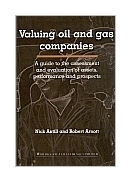|
||
• wydawnictwa polskie
• Zamów informacje o nowościach z wybranego tematu • kontakt
• Cookies na stronie |
VALUING OIL AND GAS COMPANIESANTILL N., ARNOTT R.wydawnictwo: WOODHEAD P.L , rok wydania 2000, wydanie IIcena netto: Valuing Oil and Gas Companies A Guide to thr assessment and evaluation of assets, performance and prospects In preparing the new edition of this book we have aimed to update but not to alter the original. It was originally conceived and written as a practical handbook, not a thesis or a history of the oil industry. It did and does contain some indications of our expectations for the future, but these are there to illustrate how conclusions follow from analysis of historical performance; the conclusions are not the primary objective. The most material change that we have made in this edition is to widen the emphasis from that of an investor to include that of a corporate planner. The new section on corporate activity, while relevant to the investor, is really aimed at explaining how the competitive structure of the industry has influenced company performance and how this in turn does and should influence corporate conduct. Throughout the book, we have added comments which address the concerns of the industry planner, rather than merely the industry investment analyst on whichever side of the fence. Much of the updating of examples has been of no methodological significance; it simply implies that the illustrations may be more topical to readers. Some of it has had more far-reaching consequences, where the conclusions that follow from recent structural changes do seem to be different from those drawn five years ago. Perhaps the best way to illustrate this is to comment on some of the changes to our conclusions which have resulted. In the first edition, we concluded that the best prospects seemed to lie with the larger and better-financed companies, and that the greatest challenges were faced by the niche operators, especially upstream. That conclusion has not changed; it has merely been reinforced by the drive to create 'supermajors'. Secondly, we argued that the two biggest strategic issues were how to re-enter the lower-cost but politically difficult regions of the Middle East, the FSU and Latin America; and how to manage an investment strategy in the refining industry, given the conflicting pressures of environmental controls and inadequate returns. These are still two of the key issues for the industry. In this edition, we have placed greater emphasis on the implications of gas and power liberalisation on both sides of the Atlantic. These have created the opportunity, and perhaps the need, to integrate in one of two directions: vertically, to the customer, either in gas or via power; or horizontally, across the fuel mix. For example, one could conceive of an oil company marketing gas and power but acquiring options on generation capacity without owning generation plant. Our general conclusion is that the direction in which companies move will vary from market to market, a function of how many alternative suppliers and how much infrastructure there is. The less competitive the markets, the greater the tendency to vertical integration. Both editions are open to the charge that we have made too little of environmental factors which might revolutionise the oil industry, rather than merely affecting it. These could include hydrogen fuel cells, more draconian restrictions on greenhouse gases, etc. We plead guilty. Most of these issues are currently imponderable. They should be mentioned; they cannot be quantified. This is a book about quantifying valuations of oil companies, and these issues may well become quantifiable in future years, but are not currently. Regarding valuation methodology, we have made two changes from that of the first edition. For exploration and production companies, we have put more emphasis on the relationship between their performance and the rating that the market will apply to their liquidation values. This point was discussed in the first edition; it is illustrated more fully in this one. Secondly, for the integrated oil companies, we have shifted from the use of a dividend discount approach to a discounted cash flow model. This maintains a clearer continuity with the section on exploration companies and is methodologically more satisfactory. The crucial distinction between the liquidation value approach used for exploration companies and the going concern approach used for integrated companies is inevitable, and remains unchanged between editions. As with the previous edition, the authors have made extensive use ofBP Amoco's excellent Annual Statistical Review of World Energy for source data on energy statistics for the charts in this book. We should like to thank the company for its permission to use this information. We are also grateful to OMV for permission to use an updated flow chart of its Schwechat refinery, and to Enterprise Oil for the use of two charts analysing changes in oil price expectations and the distribution of actual oil prices.
Contents 1.The development of the oil industry Oil industry history The companies Reserves and production Future potential The oil industry today 2.Economic assumptions A non-renewable resource Oil market demand The 1997 Asian crisis Ex-Communist countries Environmentalism Non-OPEC supply The economics and politics of OPEC The short term Price Refining margins Natural gas markets 3.Oil industry accounts Accounts and economics Oil company consolidated accounts Oil industry accounting conventions Exploration Accounting for value International accounting comparisons 4. Exploration and production companies The industry method of asset valuation Exploration acreage Asset value sensitivities Asset value growth Company performance Equity market valuation 5.Integrated oil companies Activities and structure Exploration and production Downstream oil Refining Marketing Downstream profitability Comparative analysis Petrochemicals Finance Share price rating Strategy Absolute evaluation 6. Oil industry corporate finance Theoretical background One world, regional variety Exploration and production companies: a special case Oil industry financing Conclusion 7. The future Industry background E and P companies Integrated companies Equity market behaviour Challenges for the future 282 pages Księgarnia nie działa. Nie odpowiadamy na pytania i nie realizujemy zamówien. Do odwolania !. |


